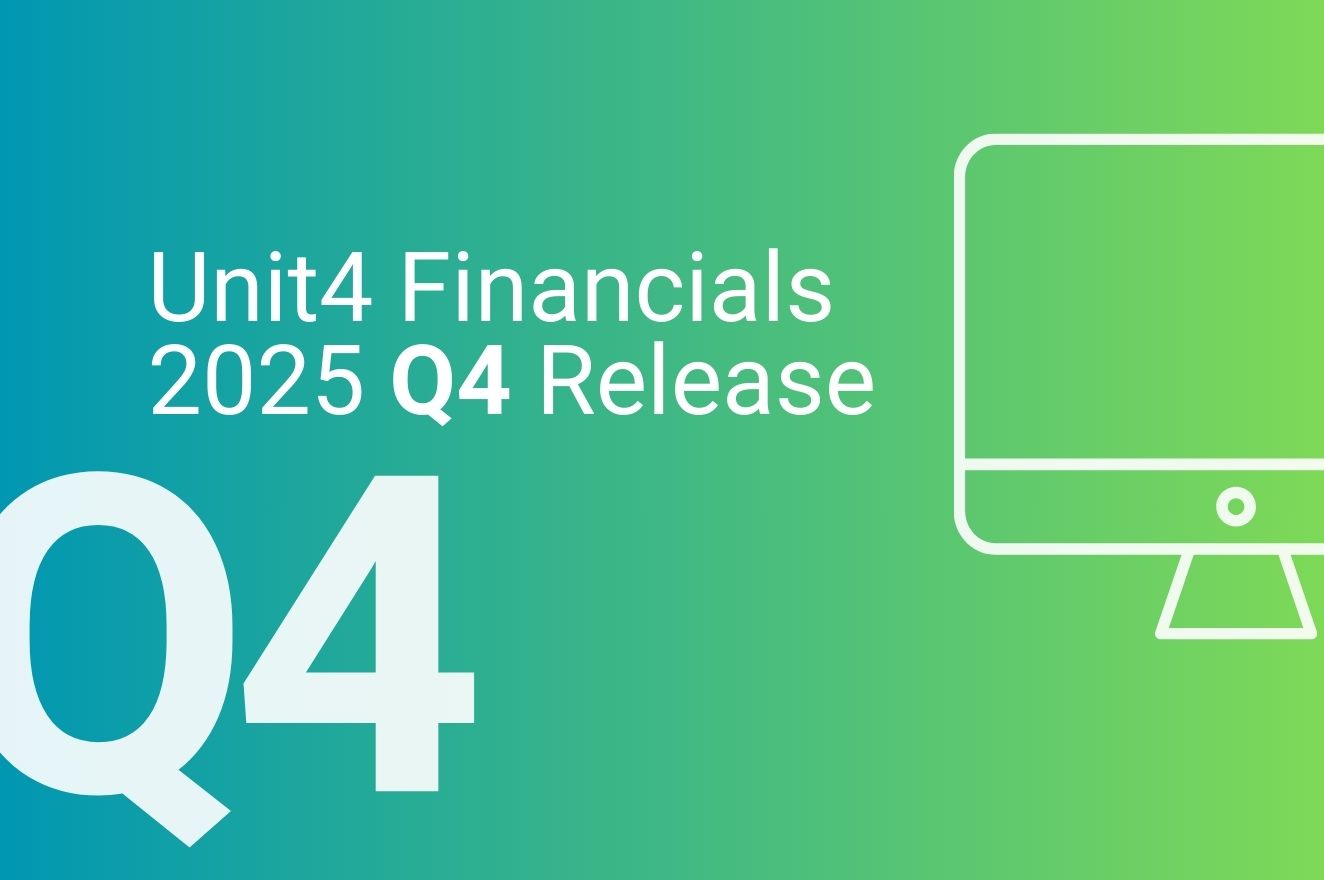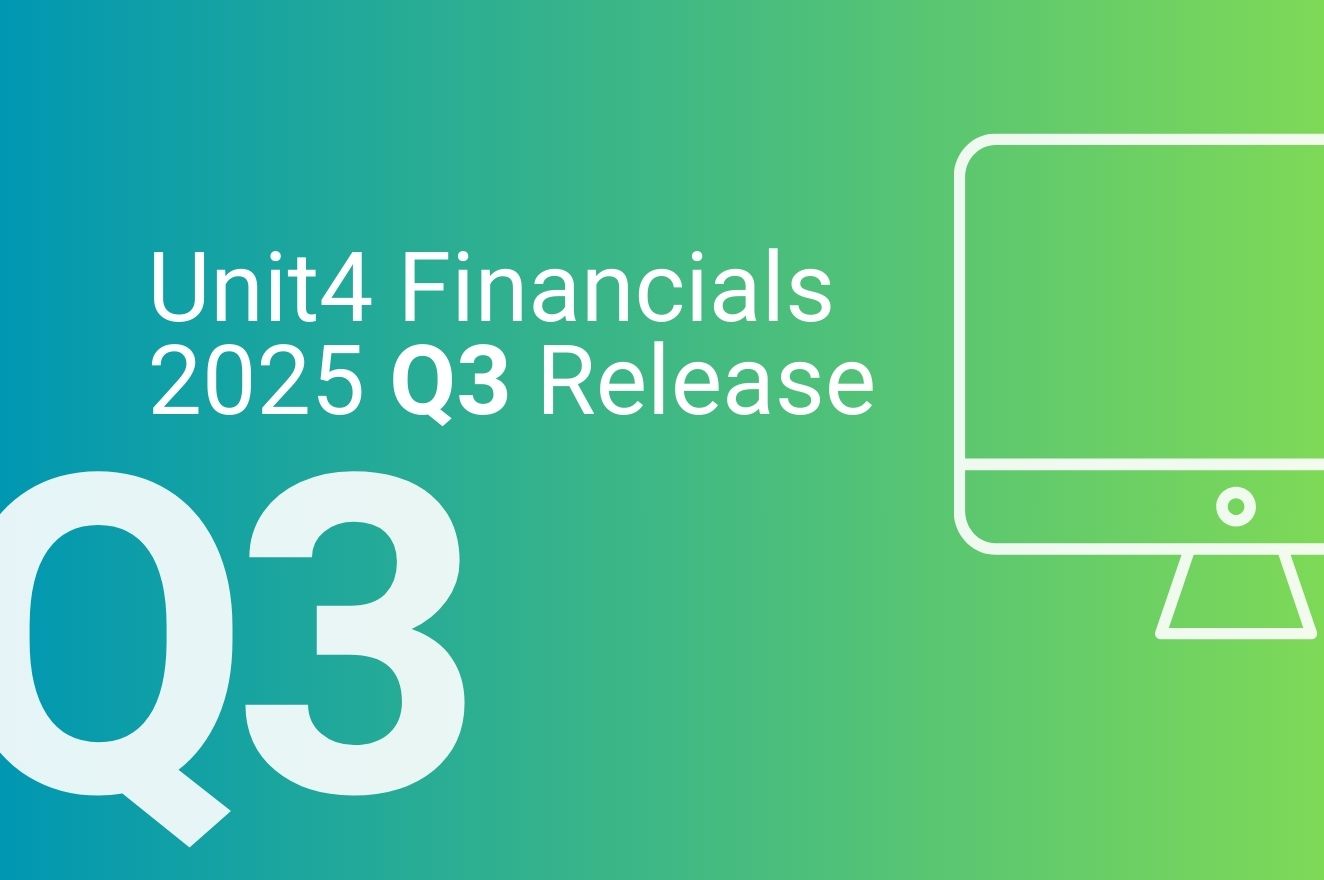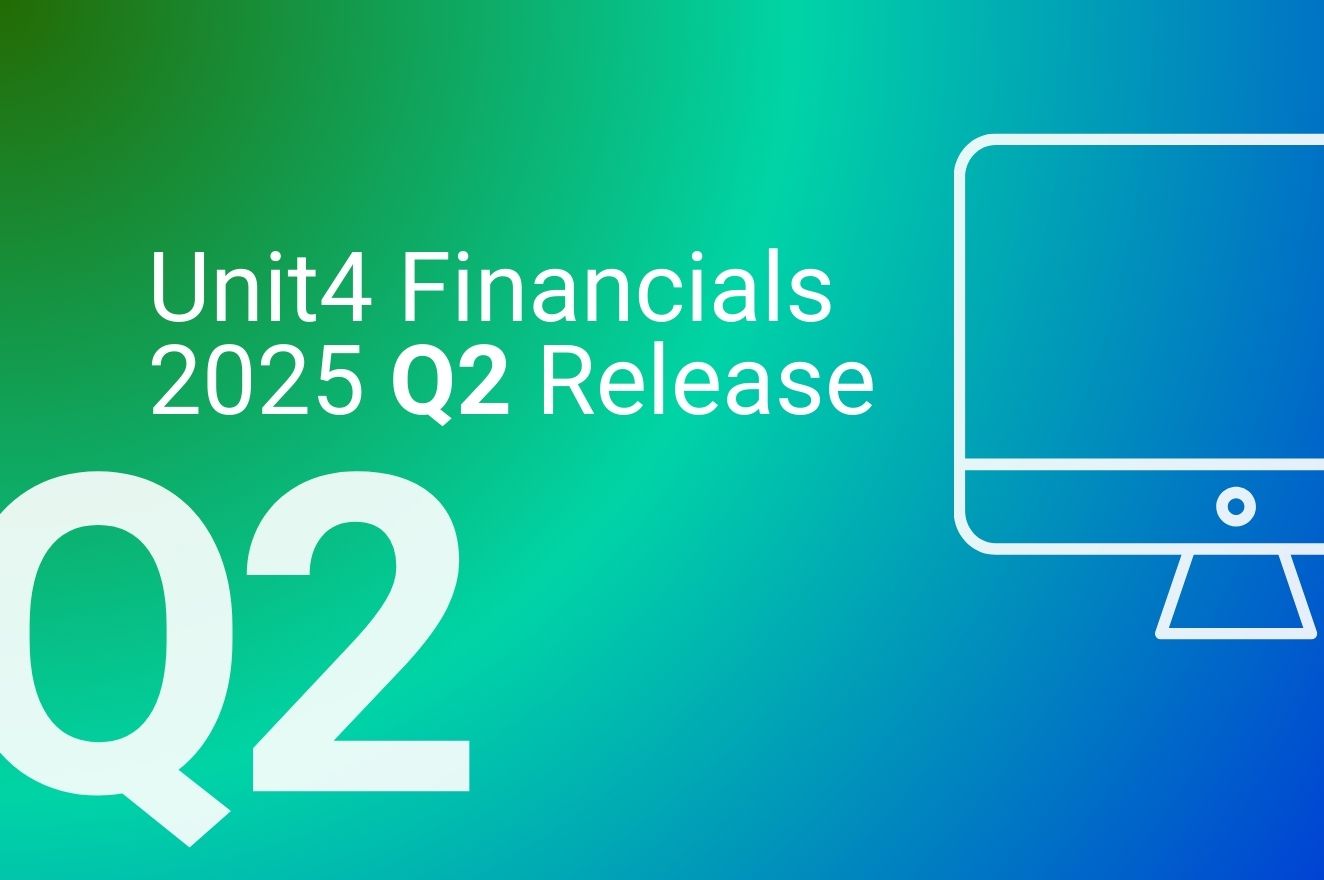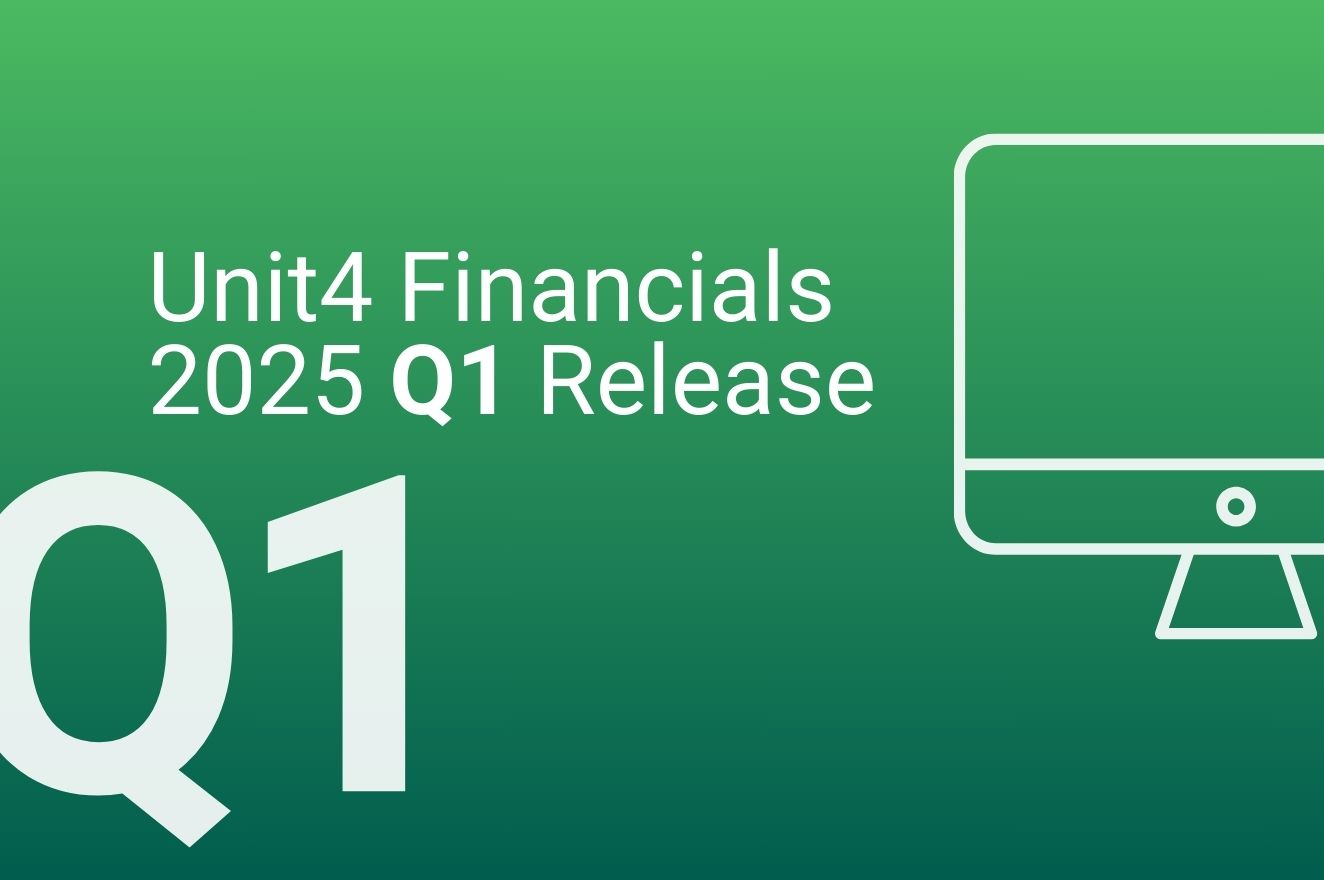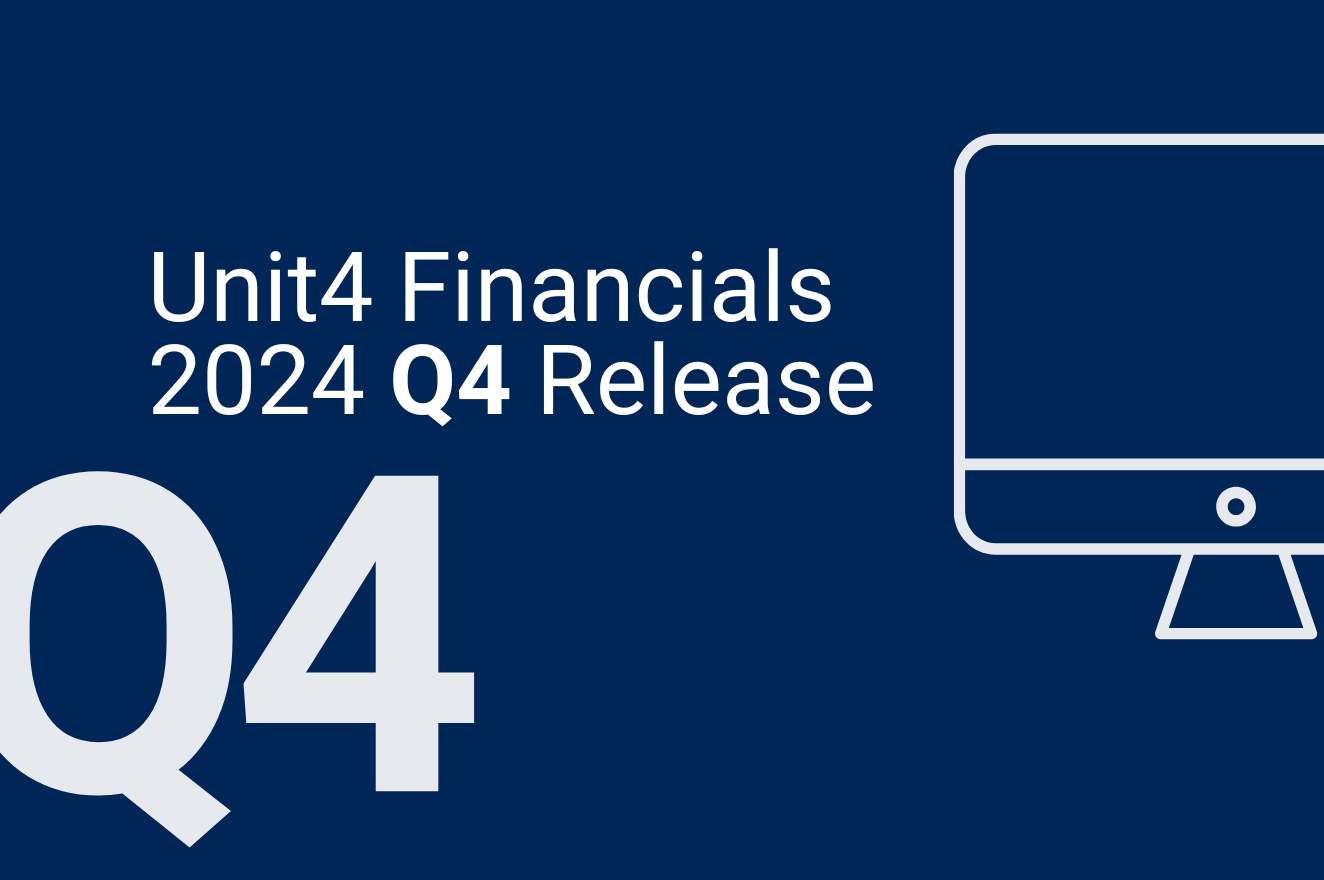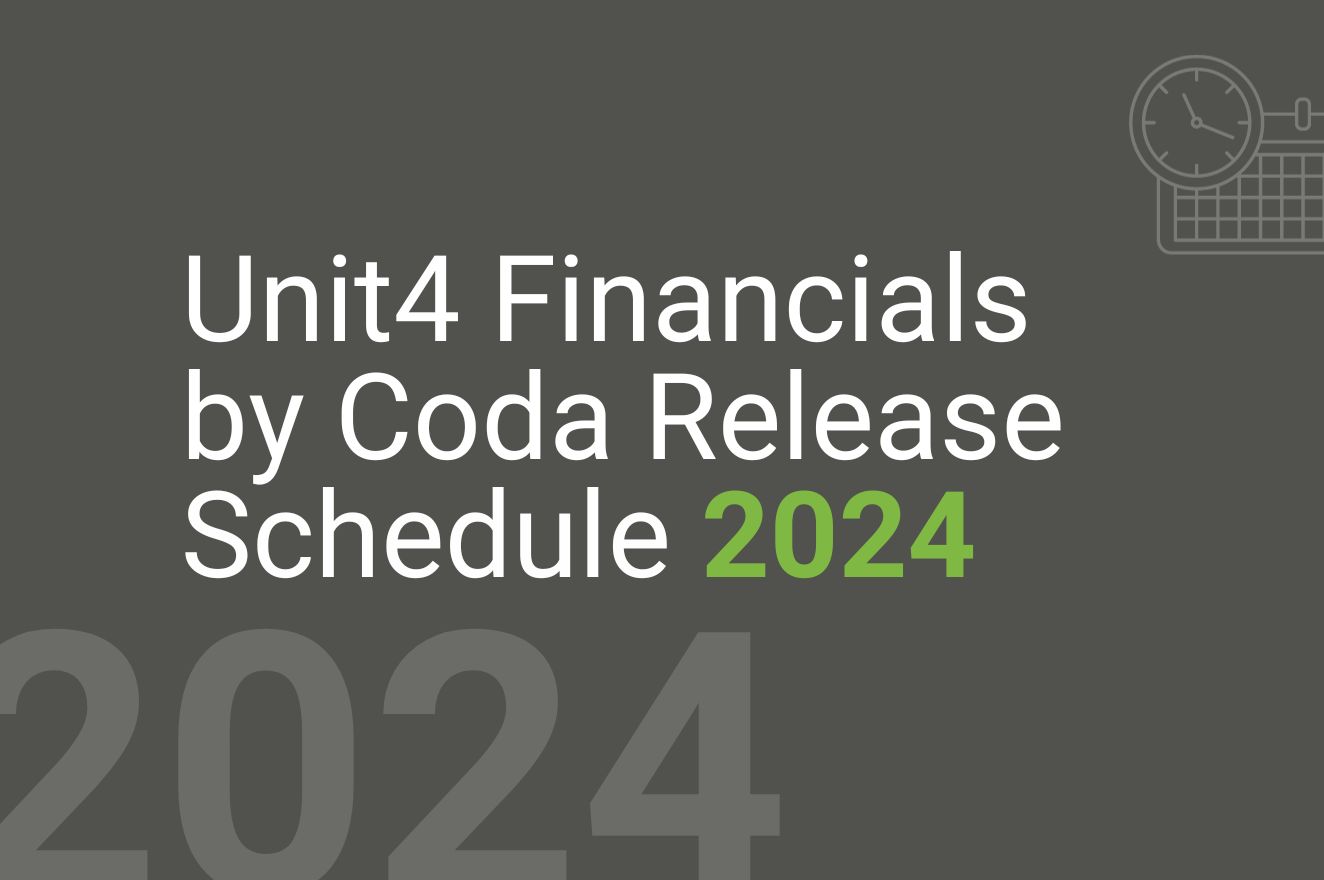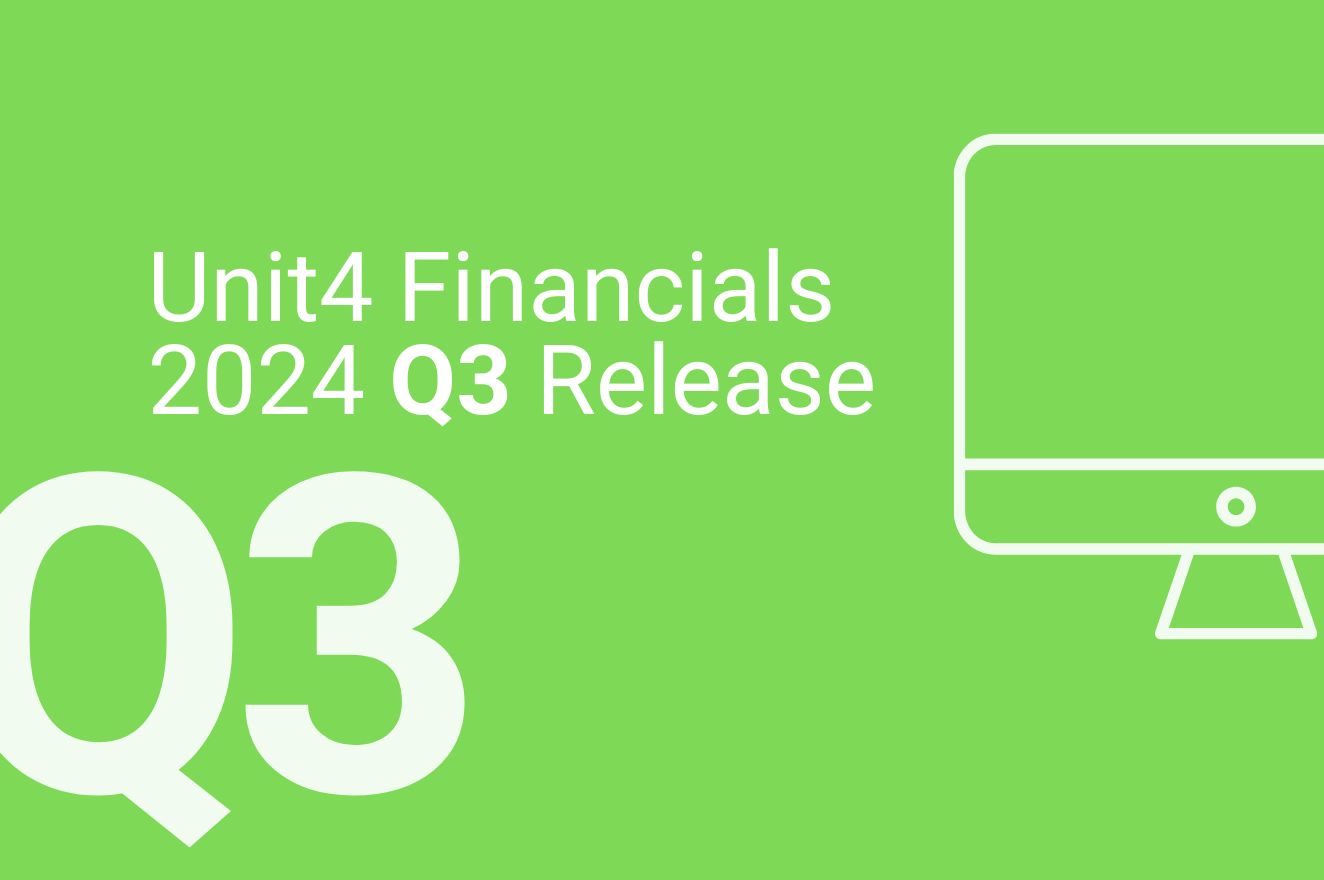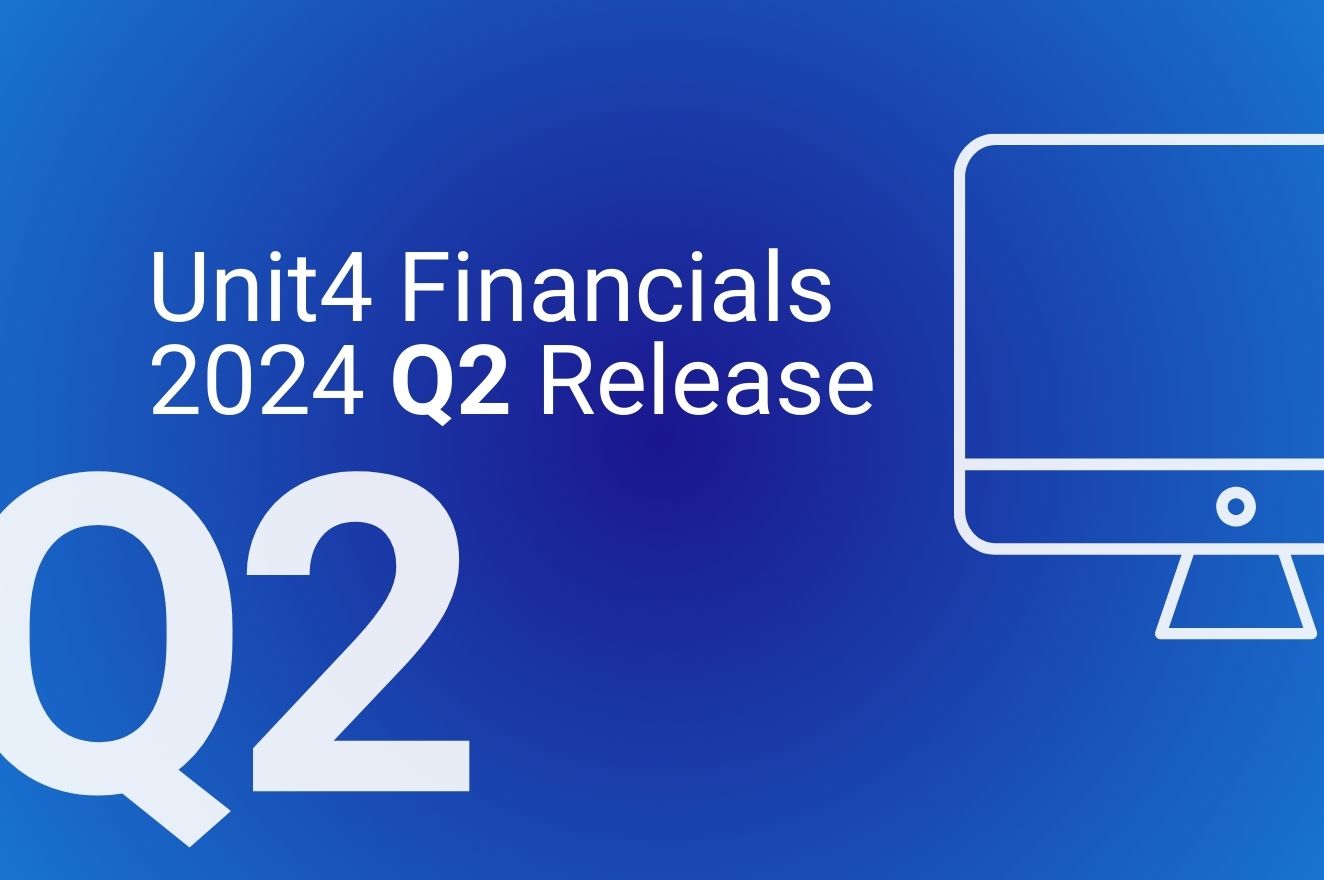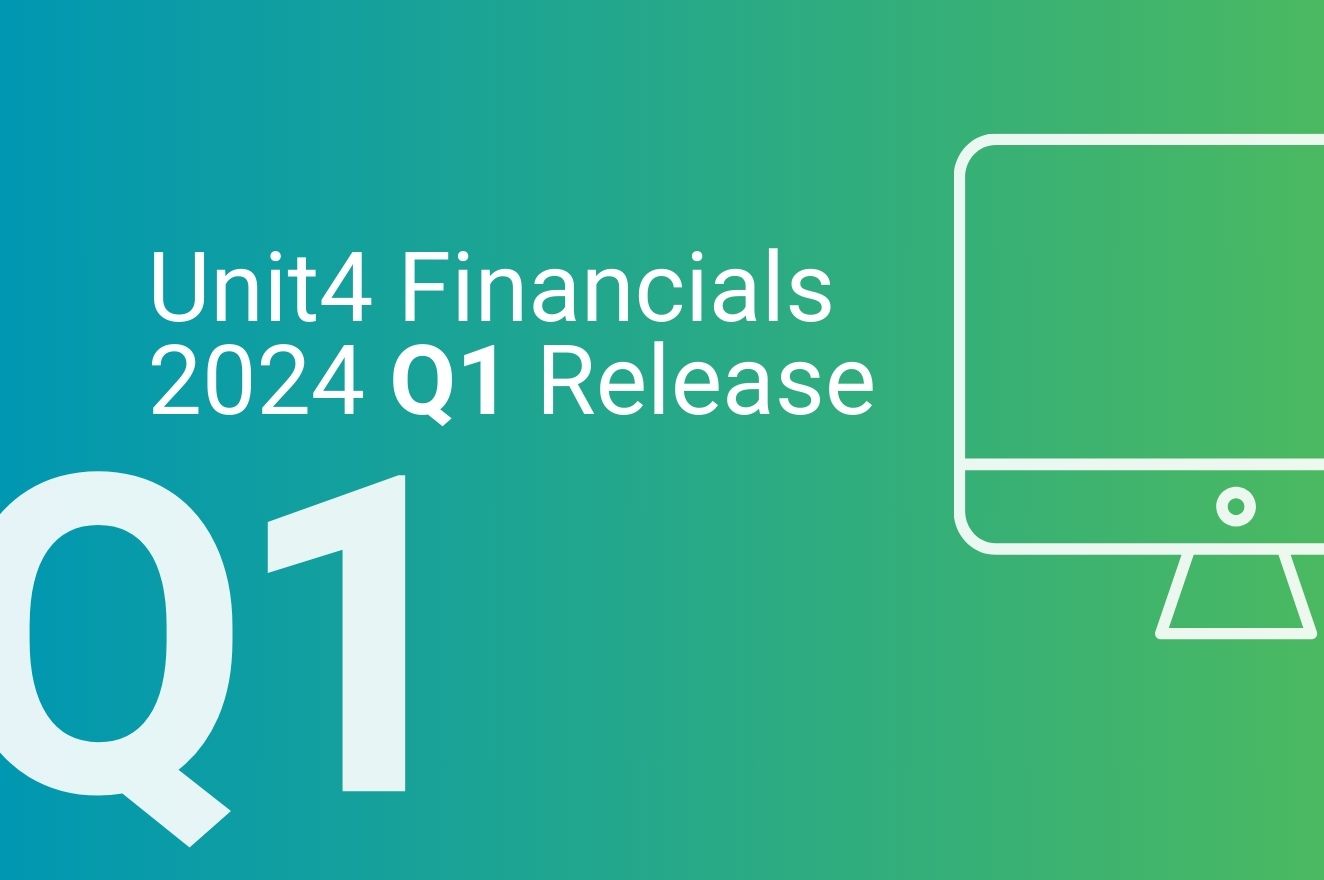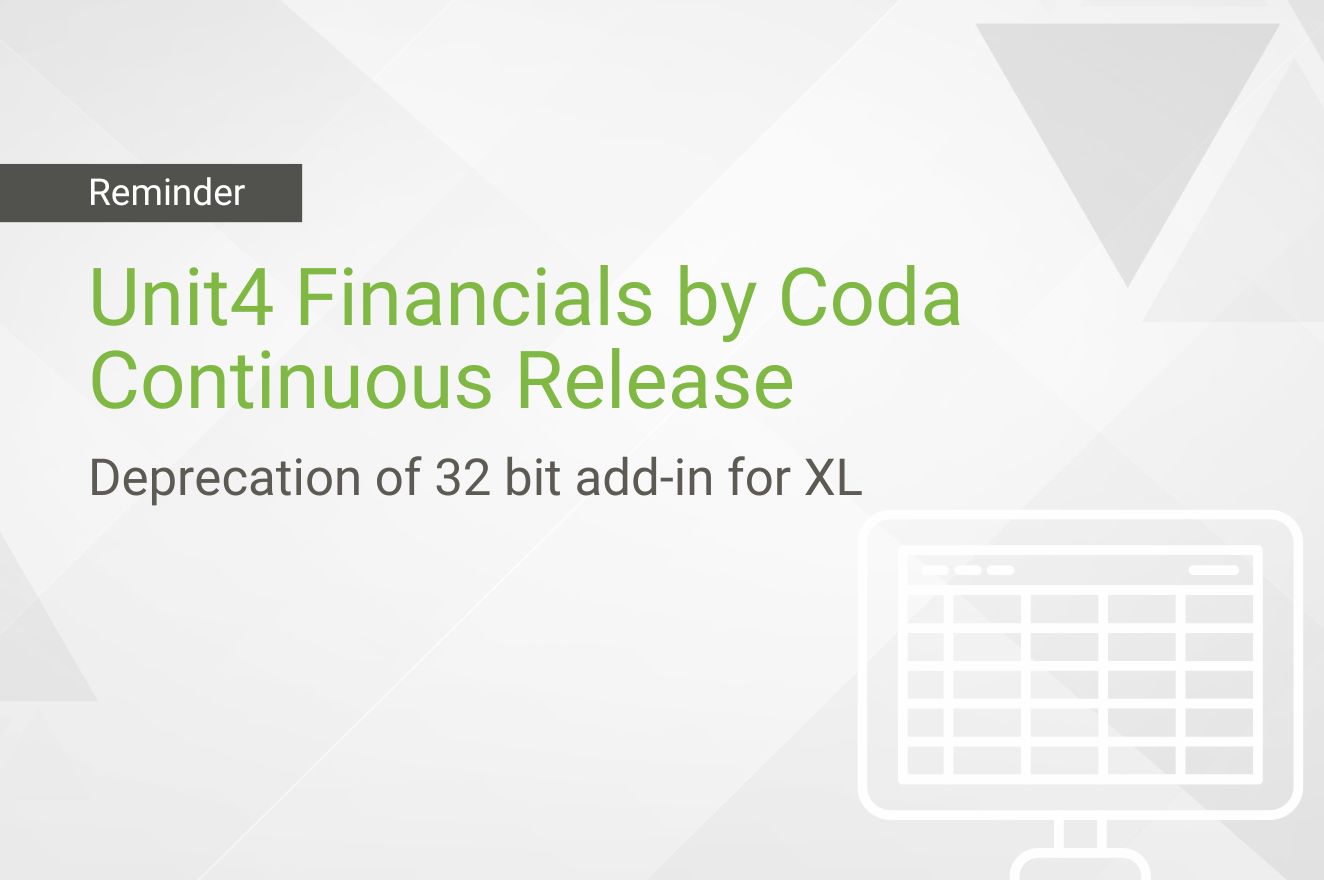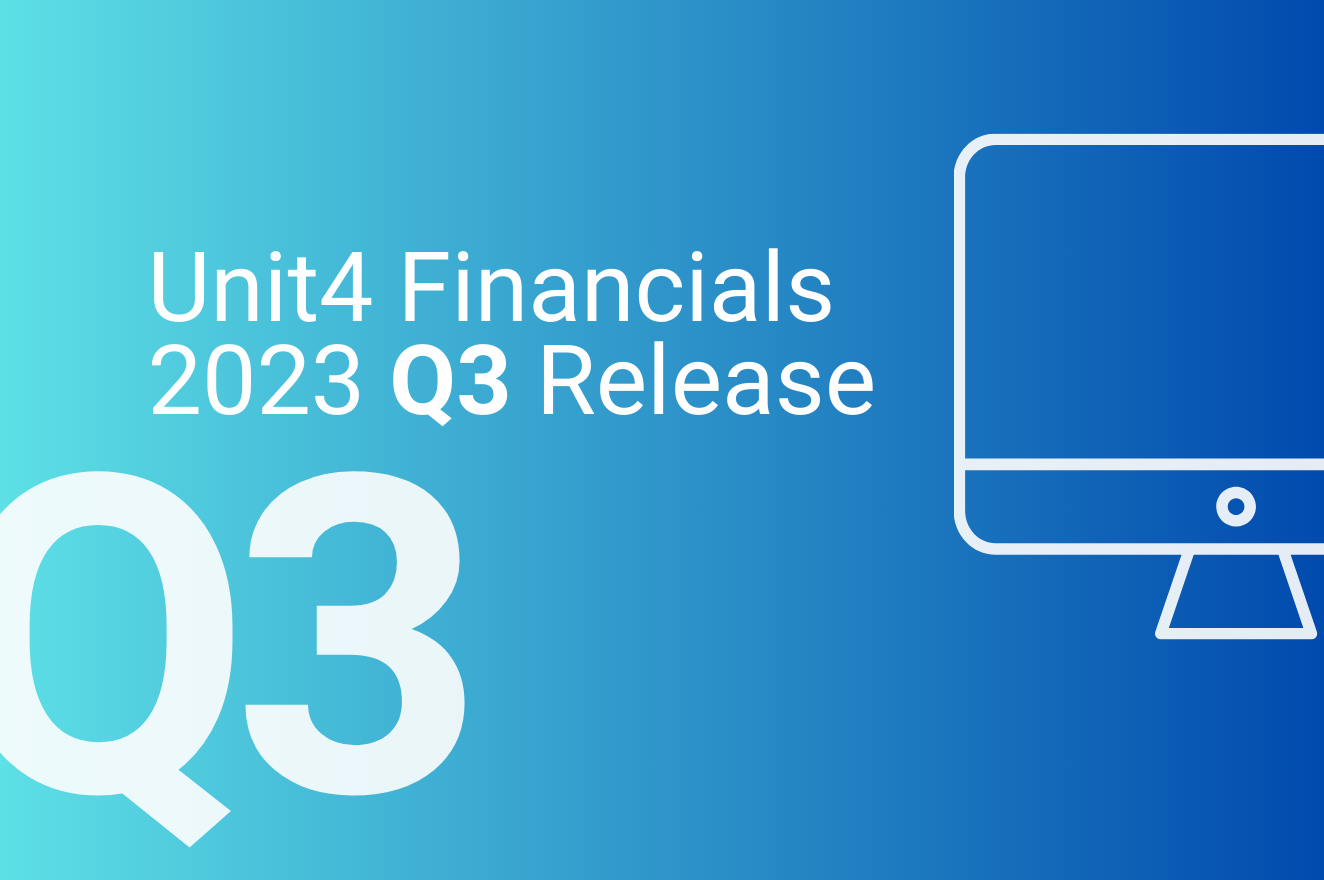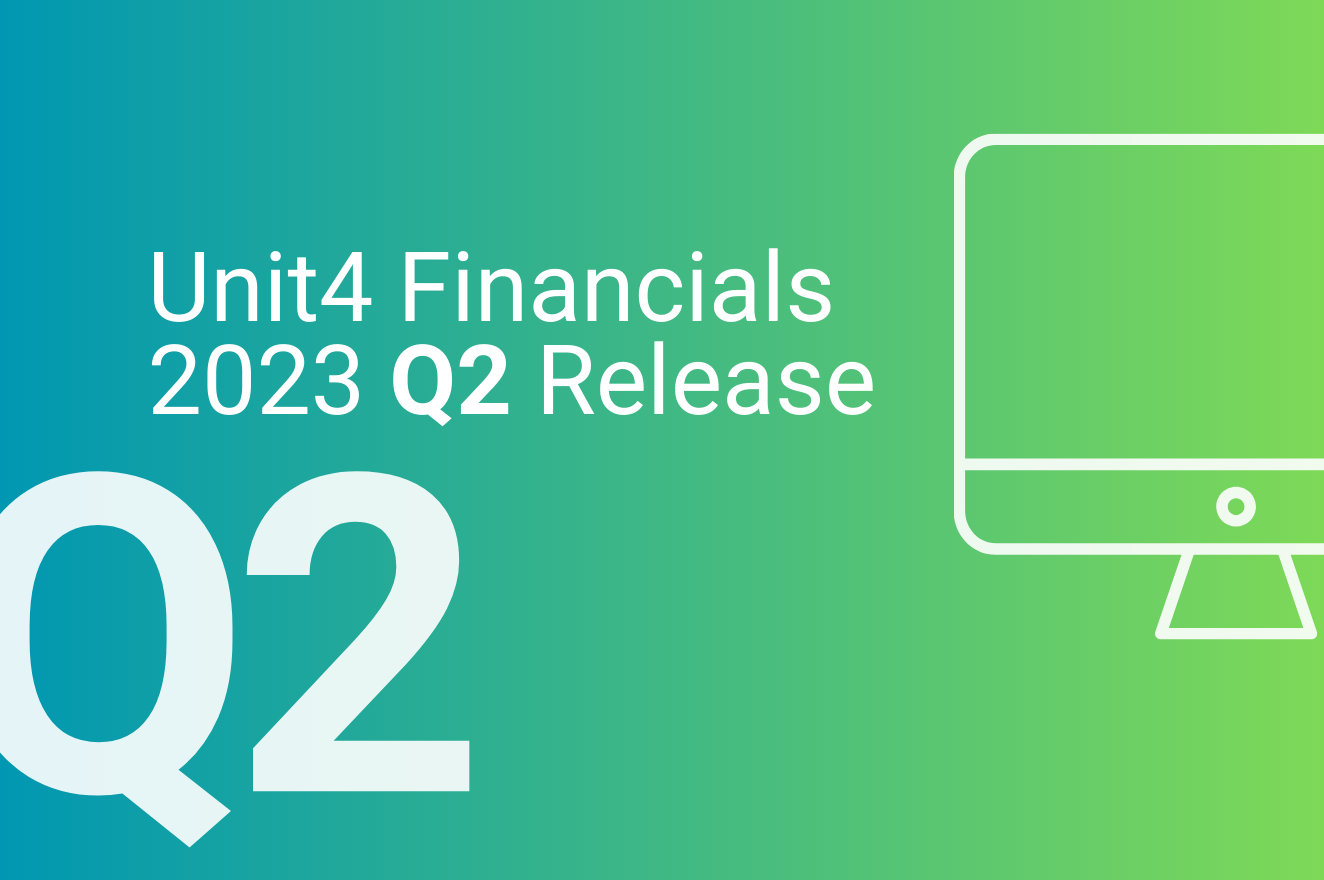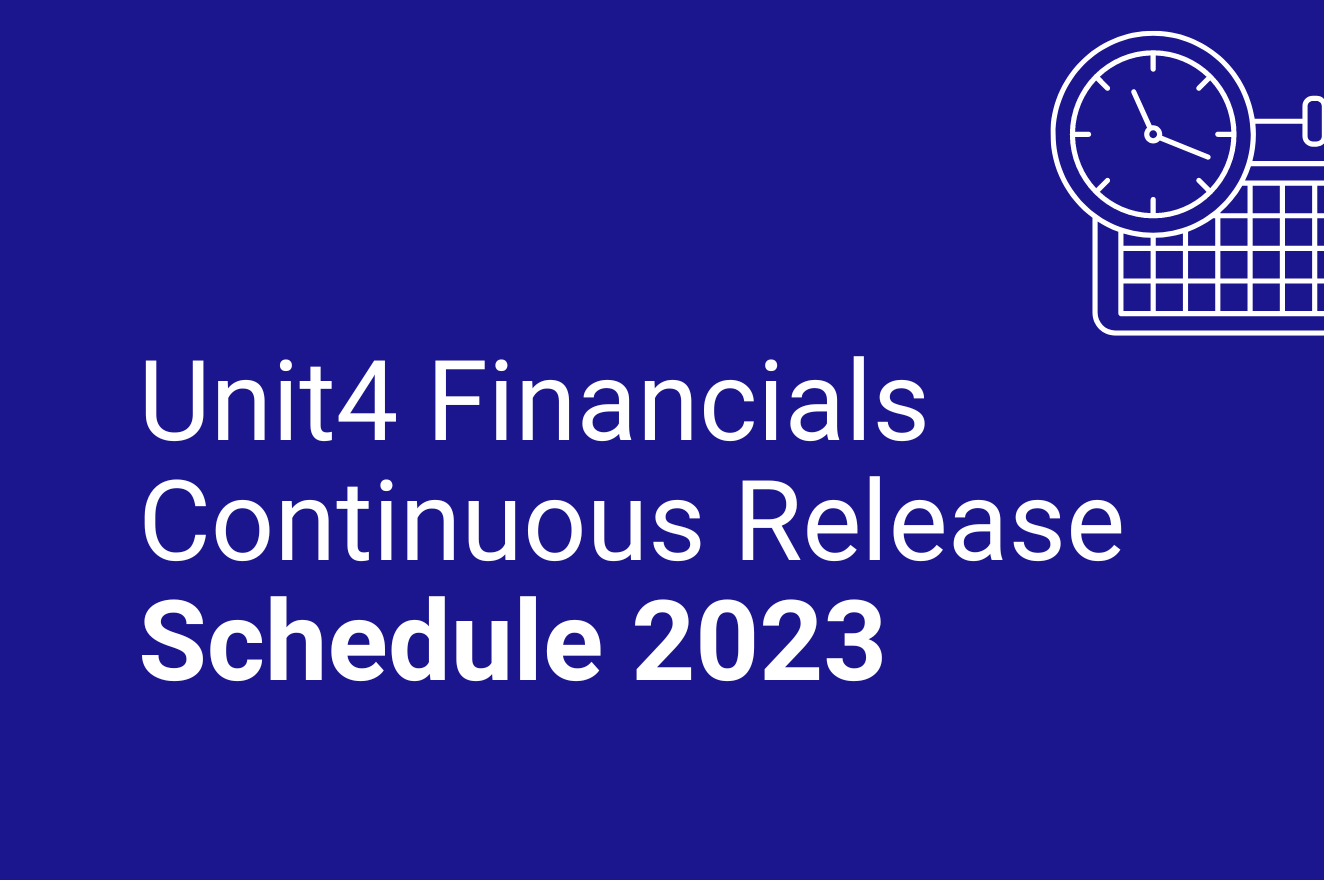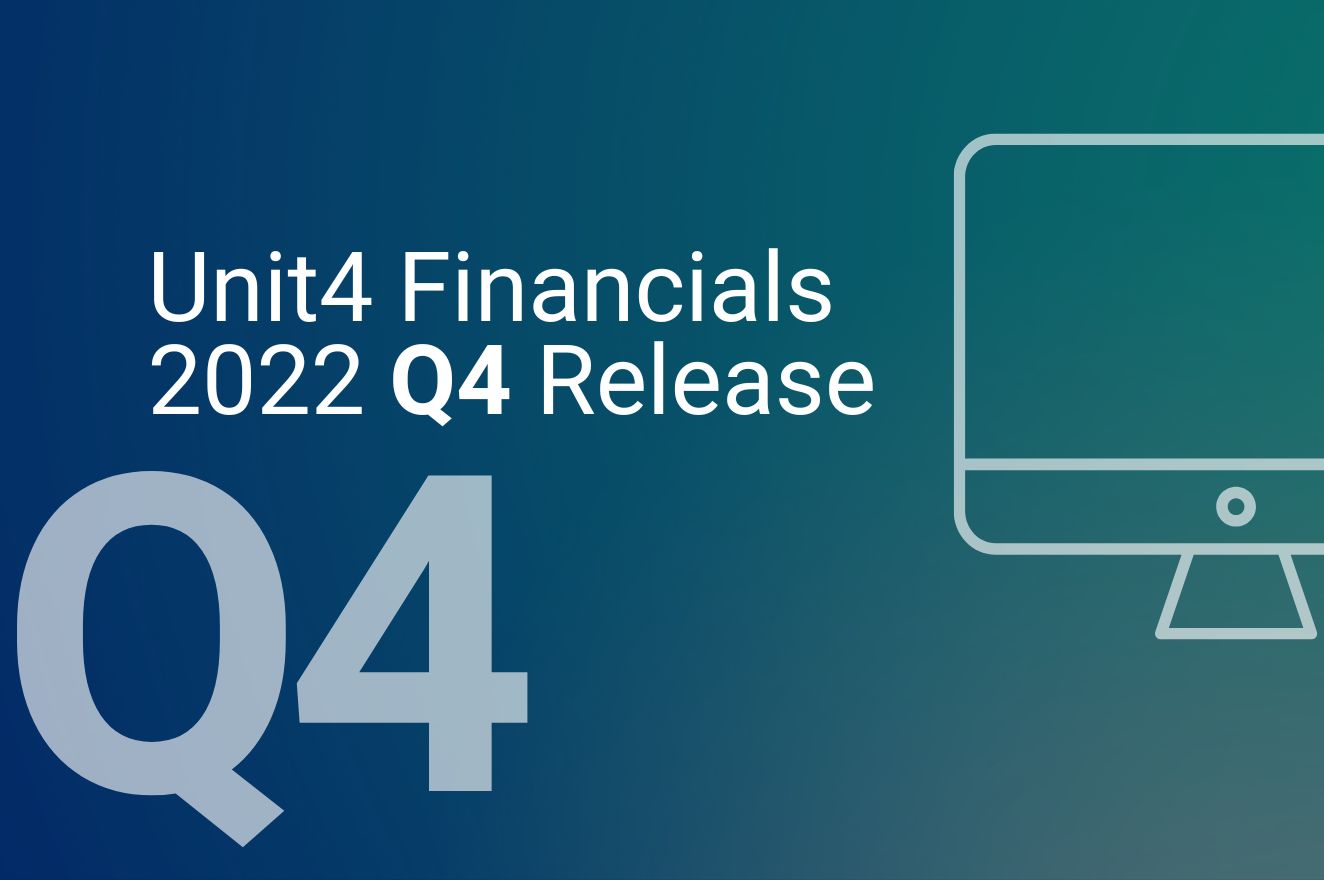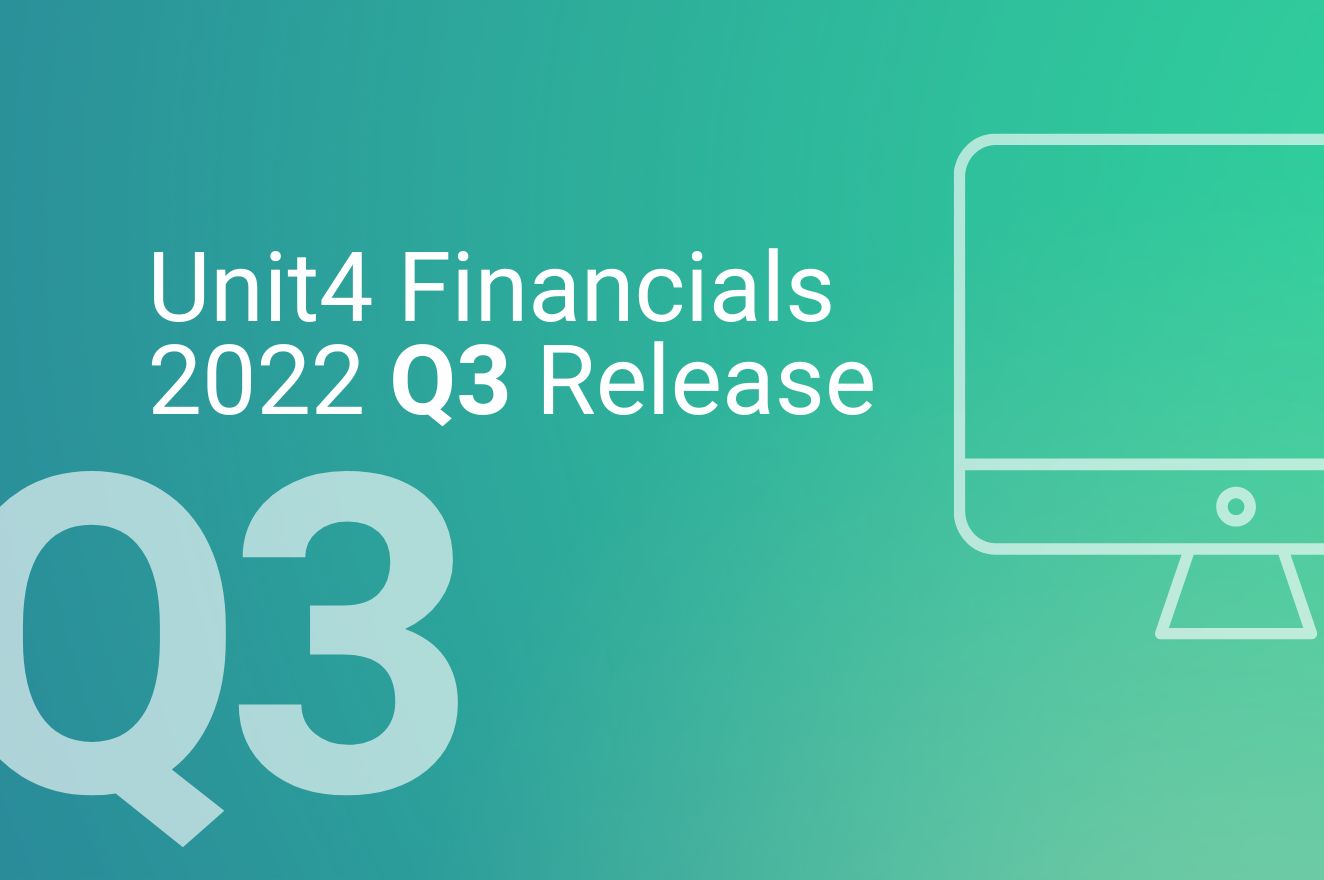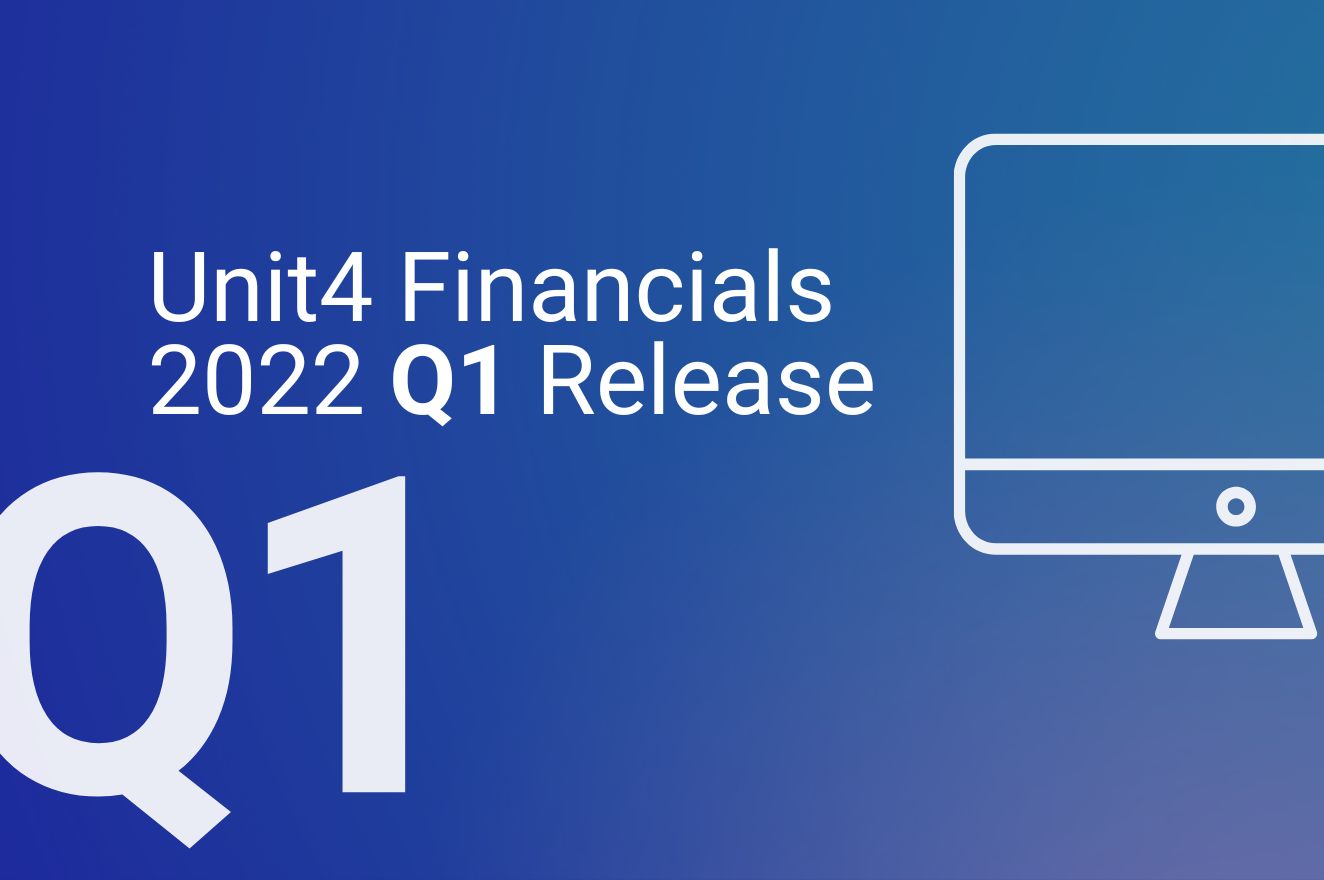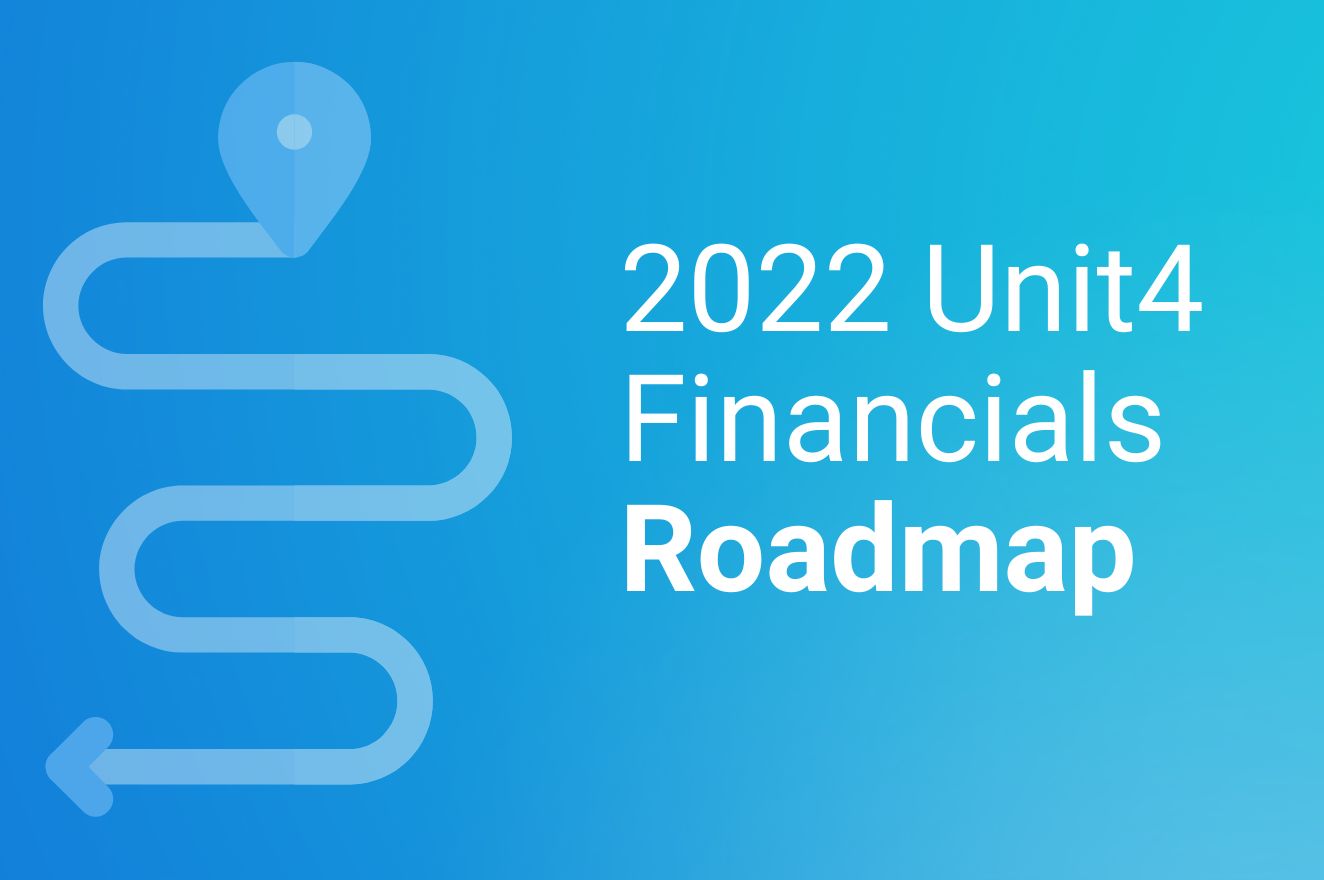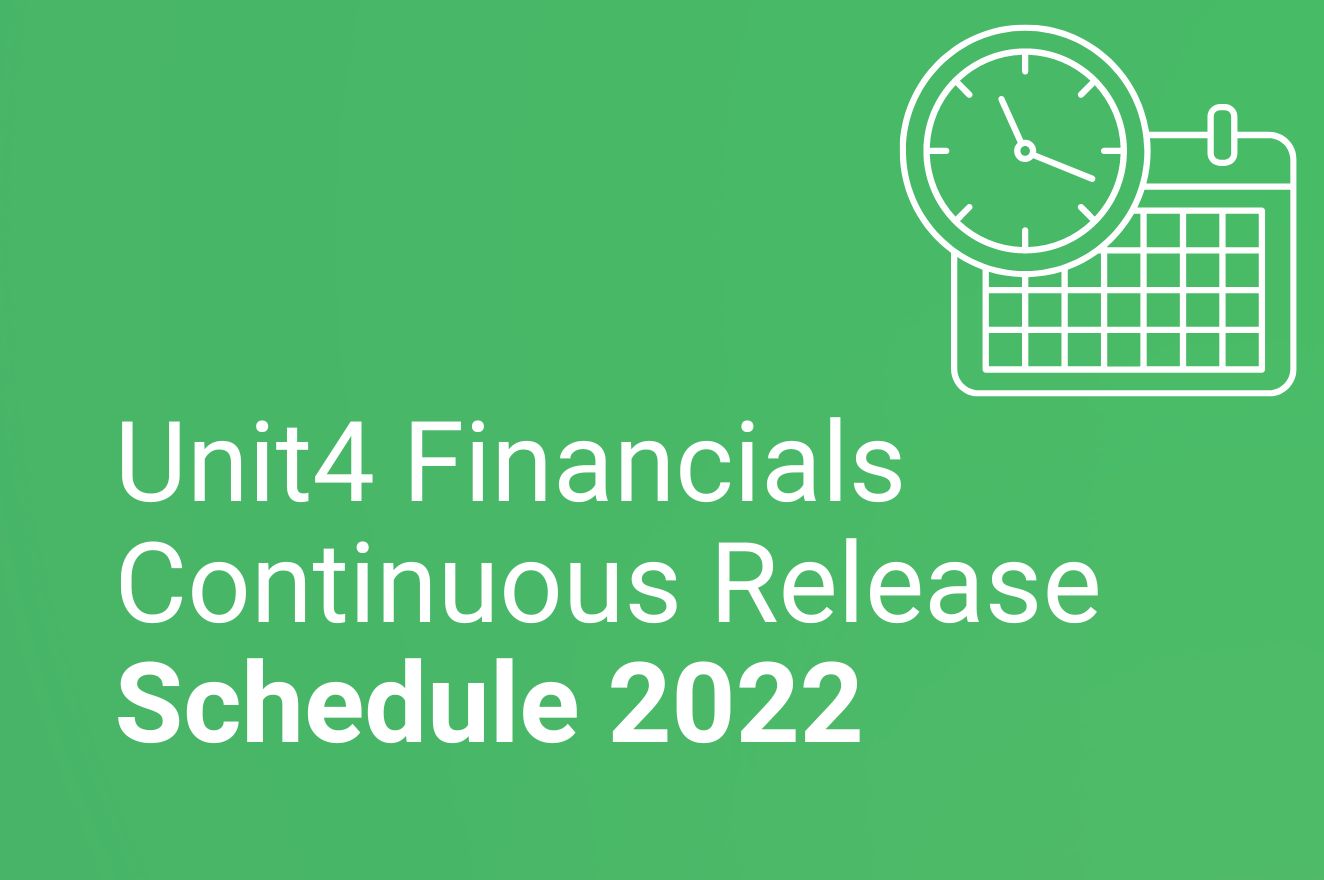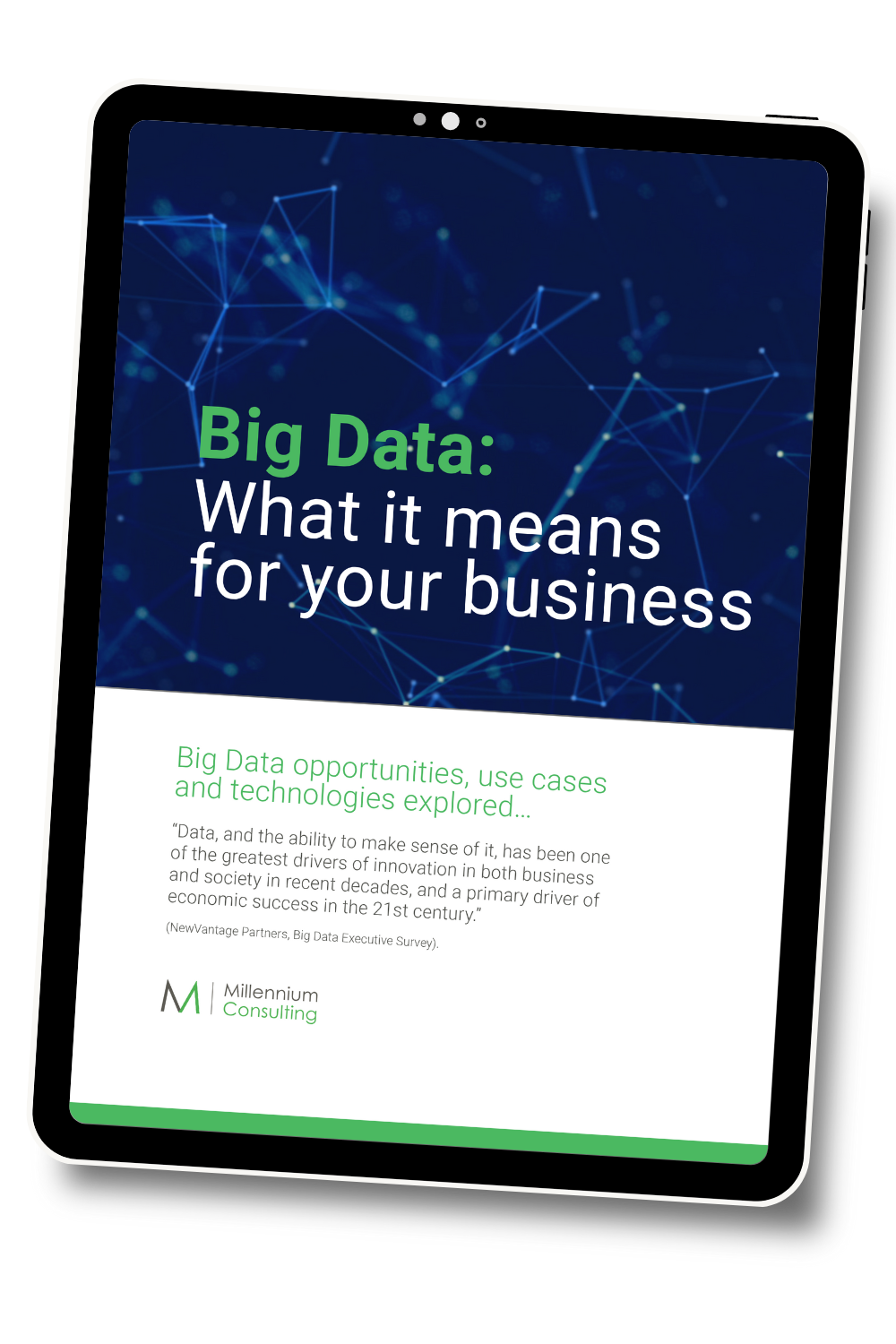Unit4 Financials by Coda Support & Maintenance Policy - October 2023
October 2023
This news article provides information on the current support and maintenance policy of Unit4 Financials by Coda software.
On 17th October 2023, Unit4 announced to its customers that it had taken a strategic decision to provide only Software as a Service (SaaS) solutions going forward, and as such on-premise Unit4 ERP, Unit4 Financials by Coda, and Unit4 FP&A will be transitioned to the cloud-based versions of these solutions.
Effective from 31st December 2024, Unit4 will no longer provide support and maintenance for the on-premise versions of these solutions and with support and maintenance for V14 having ended in December 2022, Unit4 Financials by Coda Continuous Release is now the default release supported.
The following maintenance support applies with effect from 17th October 2023:
| Product | Current Release |
Released | Base Release Date | Maintenance Method |
Critical Bug Fix end |
| Unit4 Financials by Coda CR Saas | 2023Q3 | September 2023 | February 2020 | Continuous Release |
|
| XL for Finance/Procurement | 2023Q3 | September 2023 | February 2020 | Continuous Release |
|
| Unit4 Financials by Coda CR On-Premise | 2023Q3 | September 2023 | February 2020 | Continuous Release |
31st December 2024 |
| Unit4 Financials v14 | Release 19 | December 2022 | May 2017 | Incremental Release |
Reached – December 2022 |
| XL for Finance/Proc v14 | Release 19 | December 2022 | May 2017 | Incremental Release |
Reached – December 2022 |
| Unit4 Coda Financials v13 | SP23 | December 2014 | February 2011 | Service Pack | Reached – February 2021 |
| XL for Finance/Proc v13 | 13.002 | May 2016 | February 2011 | Fix Release | Reached – February 2021 |
| XL for Invoice Matching | 5.102 | December 2013 | January 2010 | Fix Release | Reached – February 2021 |
Notes:
Unit4 Business Software provides software change request support as shown below. The term “Unit4 Financials by Coda” means the Administration, Finance, Invoice Matching, Procurement, Billing and Assets products. The term “ancillary products” means products which are:
- released together with and have the same version number as Unit4 Financials by Coda.
- release independent but work with multiple versions of Unit4 Financials by Coda.
The Unit4 Financials by Coda support team is unable to provide additional information regarding the transition and request you contact your Unit4 Account Manager, Unit4 Customer Success Manager or cloudmigrations@unit4.com who will be able to provide specific tailored information for your business and the next steps.
Stay informed
All the latest Unit4 Financials by Coda news can be found on Unit4’s Community 4U.
As an Elite Unit4 Partner, Millennium Consulting can assist with this migration; read more about our Cloud migration solution here.
Support, maintain, enhance and enrich your Financials ecosystem with Millennium+, our tailored packages to suit your Unit4 Financials by Coda needs.
Unit4 Announces the Transition to Unit4 Cloud
17th October 2023
Unit4 Announces the Transition to Unit4 Cloud
Effective from December 31 2024
On the 17th of October 2023, Unit4 announced a strategic decision to provide only SaaS solutions going forward, with the transition of on-premises Unit4 ERP, Unit4 Financials by Coda, and Unit4 FP&A – to being fully Cloud-based solutions. With effect from December 31 2024, on-premises solutions will no longer be supported or maintained, and Unit4 will offer all customers a clear migration to the Unit4 SaaS.
Read the official announcement letter from Mike Ettling, CEO of Unit4, here.
If you are currently on Unit4 Cloud, then you have no change. Any on-premise customer must have signed a Unit4 SaaS agreement by 31/12/2024 to remain supported. There will be a period after this date to allow for the migration, and Unit4 will offer legacy support, for a limited time, to those customers who have signed by 31/12/2024.
“This is an exciting and important development, and we are already in discussion with Unit4 about how to best support and transition customers to the cloud. Millennium will support you on whatever journey your business decides on.”
— Jeremy Lucas, Chief Operating Officer at Millennium Consulting
As an Elite Unit4 Partner, Millennium Consulting can assist with this migration; read more about our Cloud migration solution here.
Support, maintain, enhance and enrich your Unit4 ecosystem with Millennium+, our tailored packages to suit your Unit4 needs.
Discover the latest Unit4 news
UK’s first grid-linked solar farm
The UK’s first grid-linked solar farm: Thinking big to tackle renewable bottlenecks…
The arrival earlier this year of the UK’s first grid-connected solar farm was an important milestone in the journey towards net-zero. Phil Keet of Millennium Consulting considers how fresh thinking, updates to network infrastructure and a smarter approach to asset management all have a part to play in ensuring ambitions stay on track.
September 2023
Renewables and the issue of connectivity
Two years ago, the government committed to decarbonising the UK power system by 2035. As the Department for Business, Energy & Industrial Strategy put it, “To ensure this ambition becomes a reality, the government will double down on efforts to deploy a new generation of home-grown technologies – from offshore wind, hydrogen and solar, to nuclear, onshore wind and carbon capture & storage”.
As ever, the devil is in the detail. Policymakers tend to be very keen to talk up their support for individual projects – e.g. those linked to solar and offshore wind – as well as disruptive technologies (advanced modular reactors and carbon capture being just two examples).
However, one important fact is often glossed over. Namely; no matter what disruptive technologies reach fruition in the next twelve years, no matter how many allocation auctions are undertaken and renewables projects get underway, the 2035 carbonisation goal is not going to be met unless renewables can be incorporated successfully into the existing National Grid.
The significance of the Larks Green solar project
The National Grid was designed a century ago at a time when coal was king. The idea is a simple one: you establish your baseline and ramp up or scale down output from your power plants as demand shifts. When similarly easily dispatchable power sources came along (i.e. oil, nuclear and gas), the same principle applied – and those sources were incorporated into the system pretty seamlessly.
Renewables – particularly wind and solar – are, of course, different. The rate of power generation tends to be both intermittent and inconsistent. The grid was meant to fix the problem of meeting demand – i.e. ensuring electricity was transmitted effectively and efficiently to where it was needed. It was never designed to handle a system in which fluctuations and intermittency in supply were the norm.
Owned and operated by Cero Generation and Enso Energy, the new 50 MW Larks Green solar farm near Bristol offers a possible template for tackling some of these issues in the near and medium term.
One of the key characteristics of this new facility is scale. The plant comprises 152,400 solar modules installed in a 200-acre plant close to the National Grid’s 400kV Iron Acton substation. According to the National Grid’s press release, “It will generate over 73,000MWh annually – enough to power the equivalent of over 17,300 homes – and will displace 20,500 tons of CO2 each year compared to traditional energy production.
Secondly, the solar farm is co-located with a battery energy storage system (BESS), meaning that surplus energy generated in conditions that enable peak power generation can be accumulated. This therefore helps to directly mitigate the issue of intermittent and fluctuating generation.
Thirdly – and for this first time for a UK solar project – Larks Green provides a direct connection to the National Grid transmission network. Up until its arrival, all utility-scale solar plants were only capable of being connected to lower voltage local distribution grids. This new development means that the output of a solar plant is no longer confined to a particular area: energy can travel further, meaning that solar plants can be situated in those locations where output will be optimised – but the whole country can reap the direct benefits.
Further work to be done
Large-scale power generation projects twinned with battery storage assets are likely to become an increasingly popular model in the renewable energy market.
However, they are not an instant and permanent fix to all the issues linked to the country’s legacy National Grid infrastructure. According to the BBC’s calculations, there are currently more than £200bn worth of renewable energy projects sitting in the connections queue: the longest queue of any country in Europe.
What this means for companies
For parties involved in renewables projects, the risks associated with grid-related deployment delays need to be considered carefully in the planning process.
This issue also highlights one of the main differences between renewables projects and legacy infrastructure. Grid operators and power producers alike are going to have to come to terms with a proliferation of multiple dispersed projects. The greater the number of individual assets in play, the more challenging it becomes for grid operators to maintain strategic oversight – and for asset owners to monitor and maintain those assets effectively.
So far as reducing deployment bottlenecks is concerned, The National Grid’s ‘Pathway to 2030’ investment package is a step in the right direction, although stakeholders across the industry will obviously be eager to see further action taken at a governmental level.
In the meantime however, producers should act now to ensure that as their asset portfolio is diversified, they have the enterprise asset management (EAM) capabilities in place to ensure that assets are monitored, maintained and used effectively throughout their lifecycle.
Faced with new challenges linked to, for example, demand forecasting, load balancing and the need to minimise costs, sector-specific expertise is a must. A leader in the fields of ERP (Enterprise Resource Planning), EAM (Enterprise Asset Management) and Service Management, IFS is the go-to solution for companies across the energy sector. Find out more here.
As a premier IFS Managed Service Provider, Millennium Consulting is ideally placed to help you build the technological capabilities required for a successful renewables transition. To discover how IFS can help ensure the success of your renewables projects, speak to us today.
NIS2 is on the horizon
Cyber
NIS2 is on the horizon
On October 17th 2024, NIS2 will replace and update the older NIS (Network and Information System) regulations. NIS regulations for the EU and UK improve cybersecurity and cyber resilience across critical systems and infrastructure.
The EU has refreshed and expanded the scope of NIS in NIS2. If you provide any of the following services in the EU or your business offers Infomation Technologies services or products to an organisation in scope, you will want to check your business is compliant.
*The UK is still reviewing its own NIS regulation.
Sectors covered by the NIS Directive

Transport

Banking

Financial markets

Drinking water

Digital infrastructure

Energy

Health sector
Understanding NIS2
NIS2 is a set of regulations designed to enhance the cybersecurity of critical infrastructure and digital services across the European Union. Building upon its predecessor, NIS, NIS2 emphasises risk management, cooperation between Member States, and protecting essential services against cyber threats.
The NIS2 directive matters for several reasons:

Cybersecurity is a growing concern:
With cyberattacks’ increasing frequency and sophistication, bolstering cybersecurity measures has become paramount.

Protection of critical infrastructure:
NIS2 aims to protect critical infrastructure such as energy, transport, healthcare, and financial services. A successful cyberattack on these sectors could have devastating consequences, making NIS2’s provisions essential.

Cross-border collaboration:
NIS2 encourages Member States to collaborate on cybersecurity matters. In an interconnected world, cyber threats know no borders, and cooperation is vital for effective defence.
Extended scope for the NIS2 Directive

Postal & courier services

Manufacture of certain critical products

Water waste management

Public administration

Manufacture, production and distribution of chemicals

Providers of public electronic communications networks or services

Digital services

Food production, processing and distribution

Research

Space

Digital service providers
The countdown begins
With the NIS2 deadline just one year away, now is the time to take action. Here are some steps you can consider:

Assess your compliance:
If your organisation operates within the EU and falls under the scope of NIS2, thoroughly assess your current cybersecurity measures. Identify gaps and areas that need improvement.

Seek expert guidance:
Consider engaging cybersecurity experts who can help you navigate the complexities of NIS2 compliance. They can provide valuable insights and recommendations tailored to your specific needs.

Develop a compliance strategy:
Create a roadmap for achieving NIS2 compliance within the given timeframe. This may involve policy updates, technology upgrades, and staff training.

Stay informed:
Stay updated on any changes or clarifications to NIS2 requirements. Regulations can evolve, so you must remain informed to adapt your compliance efforts accordingly, find here.
If you need any help regarding NIS2 compliance, Millennium Consulting offers Information security support, and if you are a Millennium+ customer, you can utilise your support time for this service.
Unit4 Financials 2023 Q3 Release
September 2023
Unit4 Financials by Coda 2023 Q3 was made available on 12th September 2023.
The new release contains all the previous Unit4 Financials functionality and new features. Plus, many additional customer requested fixes, highlighting the importance of logging enhancements via Unit4’s Community 4U.
Highlights of the 2023 Q3 release include:
Administration
- Webservice Index Page
- Generic Browse
- Internet Printing Security
Assets
- Year/Period Master
Finance
- Account Summary
- Company Master
Deprecated features
- 32-bit XL is deprecated. We recommend the use of 64-bit XL.
- The Message Board feature in Administration is deprecated. It will be removed in a future release.
General Fixes/Updates
- It is now possible to change a user’s password, when the user code contains a space.
- Attachments can now be viewed from the Generic Browse Content Provider.
- The private web service ‘clientauthenticate’ is no longer included in the public web service documentation.
- An issue has been resolved where the Generic Browse Master code could not be selected when configuring a new or modifying an existing Generic Browse on a menu content provider.
- An issue has been resolved where a session would sometimes consume licences for products which were not used.
- A serious error no longer occurs when maintaining Asset category masters with no ‘Category element value’ or ‘Cost centre value’.
- Forced Prompt(s) in the selector master for Link Table Maintenance now work correctly. This has been corrected for both Finance and Billing.
- It is now possible to include the ‘@’ character in External references in documents within Finance. This means an error will no longer be generated when posting documents from Billing or Invoice Matching that contain an ‘@’ character in a reference field.
- A warning message in Matching now appears if the capability setting of matching date outside the period range is set to warning.
- Documents posted using APIs, where the document currency values have more decimal places than the currency master are now posted correctly and can now be edited on the intray.
- Emails sent as part of the Pay/Collect process, where an email template master is not used, now includes the subject and text entered at run time by the user on all emails sent and not just the first email.
- On the IBM i platform the issue which restricted the ability to write to or retrieve data from the database repository has now been resolved, the repository objects (as used by attachments) are no longer corrupted.
- A rounding issue has been resolved when calculating the Home/Dual values, this issue occurred when using reversing tax and workflow to post books on approval.
- You can now enter configuration options in the Console without the com.coda prefix. This now enables IBAN verification to work correctly in the Dutch Local product NL Common.
- The WebSphere installation scripts have been updated to accurately implement the installation requirements. The previous WebSphere scripts could result in unpredictable behaviour and failures due to the configuration not satisfying Session Management requirements.
- A reflected cross-site scripting (XSS) vulnerability in the web user interface has been fixed.
- Cross-Site Scripting (XSS) vulnerability has been resolved when viewing attachments. HTML attachments are now downloaded rather than being displayed in a new browser tab.
- XML External Entity Injection (XXE) has been resolved. XML interpreter now cannot leak sensitive server side data back to the attacker from Request Body on /coda/finance/elementauthorisationrules/uploadrules page.
Further details on the new features, security updates and reported issues can be found in the release documentation on Unit4’s Community 4U.
- Unit4 Financials by Coda 2023 Q2 was made available on 13 June 2023, find here.
- Unit4 Financials by Coda 2023 Q1 was made available on 14 March 2023, find here.
Release dates for Cloud users
Unit4 Cloud customers are notified by Unit4 Cloud support when their pre-production and production systems will be updated. This information can also be found within the Cloud Services – Release Schedules area. View the 2023 Cloud Schedule here.
The Release Notes detailing the fixes and features within this release can be found in the Documentation area on Unit4’s Community 4U.
Upgrading Financials is not merely about accessing the new functionality that comes with a new software release. It is also about mitigating technology, operational, and business risk.
Big Data: What it means for your business
White paper
Big Data: What it means for your business
August 2023
Big Data opportunities, use cases and technologies explored…
Have a read of this White Paper as it explores how Big Data is shaping different sectors and how Big Data initiatives can be of value to all areas of your business.
Is your organisation ready to navigate the data-driven world?
Our team of experienced data specialists empower customers so they gain maximum benefit from their valuable data. With decades of experience in the field, we provide strategic guidance so you can realise the full potential of your data.
MBilling Use Case: Solving Complex Billing for a Ferry Operator
August 2023
MBilling Use Case:
Solving Complex Billingfor a Ferry Operator
In terms of the sheer range of customer categories, billing methods, transaction volume and parameters to account for, billing doesn’t get much more complex than in the case of ferry operators.
Here’s a closer look at how MBilling from Millennium Consulting meets the needs of this highly demanding sector.
What is MBilling?
MBilling is Millennium Consulting’s sales invoicing solution designed for users of Unit4 Financials by Coda.
The solution is underpinned by technology from order-to-cash specialists, ICORP, and is designed to automate and streamline processes of organisations with complex billing requirements.
For an introduction to its capabilities, take a look at our guide, Complex Billing Challenges Solved: Introducing MBilling for Unit4 Financials by Coda.
Ferry Operator Use Case
The Challenge
For operators within this industry, complexity in terms of billing and, invoice management & processing arises in multiple areas:
- Customer categories – e.g. private passengers, different vehicle types, accompanied and unaccompanied freight. Service offerings for different customer groups will involve a wide range of pricing options, payment terms and invoicing procedures.
- Tiered pricing. Examples include volume-based pricing arrangements for frequent commercial users – or group discounts for private passengers. Some of these may be standard arrangements. Others may need to be negotiated on a case-by-case basis. All will need to be accounted for accurately in the relevant invoices.
- Add-ons. Parameters to be factored into invoices may include cargo handling for unaccompanied loads, short or long-term ambient or refrigerated storage, and in-crossing cabin/catering packages for drivers.
- Partnerships. With the type of add-ons listed above, elements of the service offering may be delivered by third parties. Accuracy of recording is essential for the purposes of recoupment and internal reporting.
- Multiple touchpoints. When an initial arrangement needs to be varied for private passengers and commercial customers, terms of passage may be determined by a combination of touchpoints (e.g., a passenger books via your website and then telephones to secure an add-on or discount). When bills are generated, such variations need to be recorded in an accurate and consistent manner. Siloes existing between those touchpoints may impede this.
- Cross-border and regulatory considerations. For each crossing booking, the application of levies, duties and taxes, the language used, and the layout and content of the bill may be determined by passenger type, onward-passage intentions, freight load category and volume. An incorrectly entered data point may lead to needless delays / additional outlay for the passenger – and reputational damage for the carrier.
The Solution - MBilling
Our billing solution is flexible enough to be tailored specifically to your preferred pricing and billing model. What’s more, it is powerful enough to streamline and automate that model – even in the case of multiple billing parameters and high volumes of transactions.
Thanks to this combination of flexibility and powerful processing capabilities, MBilling is already being put to work by a ferry operator to address the types of challenges detailed above.
With MBilling, you set the rules, and our solution ensures they are followed – while eliminating the time-consuming workflows and risk of data-entry errors that arise with traditional billing processes.
MBilling automatically identifies and lifts all relevant billing data and applies it to your system. It calculates the pricing considering all relevant variables underpinned by the rules set by you – and taking into account any exceptions or validation steps you need to apply. The same system generates and distributes those invoices according to your preferences. And when a bill is issued, the transaction is fed through immediately to your Unit4 Financials by Coda system.
Accurate, consistent, and easy to deploy, MBilling ensures invoicing processes support business growth – rather than being a barrier to it.
Find out more
To discover more about MBilling and how to integrate it into Unit4 Financials, speak to us today.
Discover the latest Unit4 Financials releases
The Evolution of Unit4 Financials by Coda
The Evolution of Unit4 Financials by Coda
Guest post from Dave Anstey, Engineering Director, Unit4
– August 2023

What’s the difference between run-of-the-mill and best-in-class when it comes to accounting and financial management packages?
There’s no single magic ingredient that makes a good solution great. Of course, it’s essential to get the fundamentals right – e.g., solid core accounting capabilities and a ledger that’s always in balance, a user-friendly experience, and easy integration with the rest of your tech stack. And in an ideal world, your solution should deliver visibility and control across your company’s people, processes, and systems.
However, if you really want to understand what makes Unit4 Financials by Coda stand out as a great solution, it’s worth taking a brief look at how it has evolved. Architecturally and technologically, it has been completely transformed over 20-plus years. But none of this is about extraneous gizmos or change for change’s sake. Rather, it’s about ensuring that finance departments are equipped to handle their most pressing operational challenges; whether they be new regulations, doing business in new markets and volatile conditions – or responding to internal pressures to do more with less.
Here’s a closer look at how Unit4 Financials by Coda has evolved to meet customer needs – and at what the future holds…
20+ years ago
At this time, Unit4 was releasing software versions for Coda (as it was then known) and its other enterprise offerings approximately every three years, with maintenance releases approximately every six months.
Responsiveness to customer needs was always a key part of the company’s ethos. As such, Unit4 was heavily invested in responding to what were known as SARs (special ad-hoc requests): a huge but important undertaking for the company’s maintenance and engineering teams.
As was the norm for enterprise software at the time, installation of Coda was a manual and heavily time-consuming process: a vast difference compared to today.
15 years ago
How can we get new and potentially highly useful functionality into the hands of our customers faster? This was the perennial problem faced by enterprise software providers at the time, and Unit4 was one of the companies committed to optimising roll-out schedules.
The introduction of service packs facilitated quicker routes for delivery (far more efficient and less invasive than new version releases). Inroads were also made into a quicker and easier installation.
10 years ago
At about this time, Unit4 switched to EAR files (Enterprise Archive files) as a deployment methodology for the software. Starting with the web tier, and then the application tier, the use of EARs meant deployment could be achieved much more rapidly.
This led to a reappraisal of the company’s software architecture (Why have we got separate tiers for both our software and servers – and how can this be rationalised?”)
The result was a new, single-tier structure, with the deployment of the software being the same whether it’s on-premises or cloud. This was yet another leap forward in terms of easier software deployment and upgrade.
2020 and the arrival of Continuous Release
“With our new architecture in place – and the old database and schema restrictions a thing of the past – we’ve got the ability to roll out new and improved functions very rapidly. So why not formally commit to doing this – frequently and regularly?”
From early 2020, Unit4 now releases Financials by Coda updates every three months. And given the sheer volume of new challenges finance departments have had to face over the last three years or so, the timing of this could hardly have been more relevant.
The future: Cloud
Unit4 has long been committed to developing its Cloud offering – but that’s not to say that this development doesn’t benefit on-premise deployments as well.
By way of illustration, as far back as 2012 (release Version 13), Unit4 introduced support for internet printing protocol. This was an early step to moving away from the physical server.
Until this update, if you wanted to print from Financials, you had to hook your printer off the back of the server where the software was deployed. Now you can print to any printer in the world that has an IP address, just configure it up as a printer – it’s that easy.
In Version 14 (2017) Unit4 removed the desktop as well as desktop-based integration capabilities. At this time, the company also introduced multi-factor authentication with the Unit4 identity server. All the while improving feature function, delivering products, looking after the architecture, working towards the Continuous Release model, and building Cloud readiness.
At this time Unit4 also started assessing the existing integration capabilities. The problem was that many of these capabilities were not suitable for Cloud as they were based on tables on the desktop. Table link, for example, the batch input that ‘everybody’ uses, wouldn’t work in the Cloud. So Unit4 developed a Cloud integration for Table Link.
The company also introduced safer hashing algorithms. By evolving its thinking, Unit4 is delivering a product that is not just feature-rich but is also firmly focused on keeping users safe, current, and up-to-date with technology. This is an ongoing commitment for Unit4, with improved cost of ownership and REST APIs coming up, a step forward from the previous SOAP APIs.
Next Unit4 plans to look at Office 365 Web, because (as of publishing) you still must have a desktop add-in integration for Excel. The company is also looking at containerized deployment and so on.
What does that mean to us as a Financials user?
Upgrading Unit4 Financials is no longer a complex, time-consuming task.
Since launching Continuous Release at the beginning of Q1 2020, Unit4 has issued 14 quarterly releases, with 75 (and growing!) customers on Continuous Release.
The end result is a lower cost of ownership, stronger security, platform adherence, ease of installation, and regular feature updates. In short, everything you need to ease your transactional workload, stay on top of compliance, and handle the challenges ahead.
Discover the latest Unit4 Financials releases
Safeguarding the Energy Sector and Beyond
Cybersecurity
August 2023
Safeguarding the Energy Sector and Beyond
As we fight to keep greenhouse gas emissions under control and keep household bills at affordable levels, new technologies will help the energy, utility and infrastructure sectors become more efficient and move toward Net Zero.
However, at a time when the energy sector should be taking advantage of these new technologies, it faces ever-growing risks from cybercriminals. These attacks, the protection measures used to combat them, and the legislation designed to protect everyone can heavily impact the adoption of new technology.
A look at current threats and opportunities will help business leaders in all sectors see the need for a cybersecurity outlook when introducing new technology safely; this expertise can also help you get the most out of a project.
Supply Chain Risk: SolarWinds and MoveIT
Take all the hardware and software that runs your business (unless you build and develop everything in-house). You will buy some of these as goods and services from other companies, this is your technology supply chain and in doing so, potentially expose yourself to vulnerabilities out of your control.
So, an attack directed at your company only needs to find the weakest link in your supply chain. Supply chain attack is not a theory; it is an ever-growing problem, especially if the vulnerability lets an attacker get ransomware in and data out.
The two most significant examples in recent years have been via Solarwinds product Orion (An IT administration platform with 33,000 customers) attack managed to push access for the attackers into an update. Now we have MoveIT, a managed file transfer program that is effectively still a breaking story in its scope and ramifications; victims include some of the world’s largest public and private entities.
Balancing the Internet of Things and Artificial Intelligence
Solution design is a balancing act, and some choices can be made with good intentions, typically to solve a problem, but result in unintended consequences. Unfortunately, some of the best solutions (IoT and AI) carry some of the greatest dangers.
Choices when building or buying IoT solutions need to be carefully managed; some devices carry slimmed-down low-power versions of operating systems and support software or do not have current hardware protections, making them vulnerable to many types of attacks that might now be a thing of the past in normal IT.
With everyone talking about Artificial Intelligence, the question of how we can use AI to solve our problems is increasing. From a development perspective, the ability of AI to write working code quickly might be a temptation for a pressured Dev Team. However, it again can introduce issues, as the bases for the AI’s learning include depreciated and vulnerable code.
The right tools: IFS FSM and IFS Cloud
IFS FSM has been named Gartner Field Service Management Magic Quadrant Leader for seven years. It provides an end-to-end service management solution, allowing companies in the energy sector to reduce the complexity of their IT supply chain.
In addition, IFS’s Cloud offering is designed to cut technical complexity and use inbuilt automation AI and IoT input to improve efficiency and workflow while being protected by IFS’s ISO 27001 compliance.
The proper support: Millennium+
Millennium Consulting has ISO 27001 accreditation and takes Cybersecurity and Cyber resilience seriously for us, our partners, and our customers. We also aim to make processes as efficient as possible, meaning less complication for cyber criminals to pray on.
Our Millennium+ service offers you peace of mind, as you can use your time to book any of our experts for any part of your business. Be it a cyber resilience review, help with a stalled implementation or a process review, or one of many other services we can help.
Complex Billing Challenges Solved
July 2023
Unit4 Financials by Coda
Complex Billing Challenges Solved:Introducing MBilling for Unit4 Financials by Coda
As a business evolves, the finance function must ensure that billing processes remain fit for purpose. A sub-optimal billing system can leave you with cash flow woes, revenue leakage, dissatisfied customers, and a mountain of extra work to handle.
Millennium’s powerful sales invoicing solution, MBilling can provide a future-proofed alternative to legacy processes. Designed for Unit4 Financials by Coda customers and underpinned by order-to-cash specialists, MBilling ensures billing processes are able to support business growth – rather than being a barrier to it.
Here’s a closer look at the challenges associated with complex billing and at how MBilling can address them.
Complex billing defined
According to McKinsey, 71% of consumers expect a personalised approach from the companies they do business with. Meanwhile, 80% of B2B buyers expect the same buying experience as B2C customers, with 65% of business buyers saying vendors are not demonstrating an adequate understanding of their needs.
With customers increasingly demanding a personalised service, many businesses are finding that a rigid approach to billing is no longer good enough. Tailor-made packages and usage-based pricing are often a much better fit for customer expectations than ‘take-it-or-leave-it’ bundles.
Between 2021 and 2022, the global subscription market grew from $72 billion to $120 billion. It’s part of a wider trend of businesses taking a long hard look at pricing and distribution before tweaking – and in many cases, overhauling – their model. The end result can often be a complex web of tiers, personalised price plans, subscription options, and add-ons.
All of this has a direct impact on accounts receivable. Whenever pricing policies are altered to make the customer experience more personalised, rarely do those changes make the model simpler! Invariably, the list of variables by which you engage financially with customers will be extended substantially.
The end result is that you find yourself operating in the realms of complex billing. This is where invoices are no longer dependent solely on volume or time. Rather, billing takes into account a wide range of parameters, which could include bespoke contractual agreements, customer type, size and location, preferred payment method, loyalty discounts, and special plans (to name just a few).
Complex billing challenges
When it comes to administration and management, complex billing can give rise to the following issues:
In a simpler world, drawing up an invoice meant checking the volume and matching it against a set price list.
Once you are in complex billing territory, there is a much wider range of variables to take into account. What category does this customer belong to? What does the contract say? What optional extras or discounts are relevant? What special terms have been agreed at different stages of the customer journey?
The answers to these questions may not all be in one location. Depending on your tech stack, key information could be scattered across various CRM and finance systems, contract repositories, pricing documents, spreadsheets – and even email threads lurking in account handlers’ inboxes.
Against this backdrop, the billing process involves the collection and consolidation of data from disparate areas of the business from multiple systems and in multiple formats. It’s a recipe for error – and for a drawn-out process.
Difficulties with complex billing are often compounded in the case of transactions with an international element. Along with all the data-gathering issues detailed above, you can also find yourself dealing with complications over region-specific pricing policies and currency conversions. This may be in addition to VAT, invoice formatting and other regulations that can vary per product, per customer, per company, and per country.
The business risks associated with sub-optimal billing processes are pretty obvious. If those processes are prone to error, this increases the likelihood of customer queries, lengthening the time-to-payment – with knock-on implications for cash flow, and possibly also revenue leakage.
Does this enterprise client’s 5% volume discount apply before or after the loyalty bonus? Should I treat this element as part of the package or as an optional extra? If billing is a manual process with lots of variables to consider, it can increase the chances of finance team members or branch offices adopting their own interpretation of the rules.
The emergence of an inconsistent billing process is a further risk that should not be overlooked. If your customer’s accounts payable team notices that bills vary from quarter to quarter – depending on whoever happened to be responsible for calculating it – then an erosion of trust is inevitable.
A company’s billing process tends not to be simple one day and then complex the next. More typically, it grows in complexity as go-to-market and pricing strategies evolve. Consequently, the workflows linked to billing – e.g., the systems you need to access to gain relevant information, pricing data to consult, and the signoffs to seek – can also evolve over time.
One problem here is the risk of a single point of failure, e.g., the existence of just one person in your team who understands the Excel formula used to apply a certain billing rule in the right way.
Another problem relates to the onboarding of new people. Longstanding team members will have absorbed your various process changes organically over time. For new recruits, however, it’s a case of getting them familiarised with what may be a complicated and counter-intuitive series of tasks. Training in this area can be a complex process in itself.
What is MBilling?
MBilling is Millennium Consulting’s powerful and flexible billing solution, designed to address exactly the kind of issues detailed above for companies with complex needs, or who need to generate high volumes of invoices.
The solution is underpinned by ICORP, a leader in order-to-cash technology, designed to be customised to precisely meet your billing requirements – however complex your operating model.
Seamless integration is a key feature of the solution. It is built to work with Unit4 Financials by Coda, both on-premise and in the cloud. It offers frictionless integration with whatever ERP system you use, external applications and databases – including Microsoft Excel and email solutions.
How does MBilling work?
With MBilling, you can finally replace those error-prone and resource-intensive workflows for the collection of the data from disparate sources necessary to generate invoices.
The ICORP algorithms under the bonnet of MBilling are data miners par excellence. The system will automatically identify and lift all relevant data – including, for instance, email attachments – and apply them to your system as structured data. The process is quick, accurate and error-proof.
Through its calculation engine, MBilling can calculate the pricing for your billing, taking into account all relevant variables (e.g., tax, product, customer characteristics, etc) according to rules defined by you. The process is fully automated but also allows you to set whatever validation steps you wish to apply. The system can also deal with automated intercompany bookings – with a useful function dedicated to royalty rights. (It is also possible to turn MBilling around, for instance, artists and producers could use the system to send a payment run.
Once the system has completed the complex billing calculation, the bill can be generated automatically.
If you want it to, MBilling can take all the invoices for one specific party and consolidate them in one large invoice. The frequency at which it generates invoices and all the rules behind it are completely configurable by you. It can do one-to-one invoicing if you want to. It can deal with multi-language invoicing – it will recognise the individual recipient and compile it accordingly. The solution can handle reverse billing and invoicing, repeat billing and invitation to invoice. All with validation and approval where desired.
You can also configure your solution to automatically forward invoices to relevant internal parties for approval.
You can configure rules for invoices to be printed, emailed internally or externally, or integrated according to whatever policies you have in place.
Relevant information will be posted automatically to Unit4 Financials, including intercompany processing where relevant. This full Unit4 Financials integration applies whether you are on the cloud, SaaS, VM, or on-premise.
The ICORP Intelligence Monitoring Tool is hardwired into the MBilling solution. This ensures full data alignment so that when a bill is issued, the transaction is fed through immediately to your master data, so you always have access to a real-time picture of business performance and financial health.
What next?
By implementing MBilling, Unit4 Financials users can always be confident that invoices are accurate and submitted in a timely manner – no matter how complex your operating model is. To find out more, download our factsheet or submit your details and one of our MBilling experts will be in touch.




